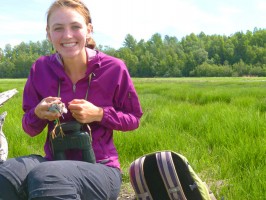
Tess Forstner, a junior at UAA, spent her Alaska summer dressed in Xtratufs, wading through wetlands on a quest for chicks. Boreal birds, actually. She also wrangled a couple dozen volunteers who were willing to tromp through their backyard wetlands in Anchorage and the Matanuska Valley to monitor target species—Lesser Yellowlegs, Greater Yellowlegs, Solitary Sandpipers, Rusty Blackbirds, Olive-sided Flycatchers, Tree Swallows and Violet-green Swallows. Each sighting of the highlighted species meant a 30-minute phone call for Tess from an excited birder. And she loved every minute of it.
A scholarship from Audubon Alaska and funding from UAA’s Center for Community Engagement & Learning made it all possible.
“My job was the highlight of my summer!” Tess says. This was her first foray into field work and, despite the mosquitoes and pervasive “bog smell” on her clothes after a day in Potter’s Marsh, she is already looking beyond her final two years as an environment and society major and on to graduate school.
“I think I want to get a Ph.D.,” she says with a smile. That’s the power of nature in the right hands. Working with volunteers, Audubon Alaska staff and her mentor and professor, Audrey Taylor, Tess coordinated a large monitoring effort for boreal birds across 32 wetland sites in Anchorage. She also helped Lee Tibbitts, a researcher with U.S. Geological Survey, capture and recover Lesser Yellowlegs to examine migration patterns.
“Catching birds is way cooler than I ever thought it would be,” says Tess. “The first time I caught a bird, I hadn’t really figured out birding yet—it’s something that takes a little time to get into. If you only know five species, how exciting is that?”
But her first day out with Tibbitts and a mist net, she held a wild bird in her hands.
“It is really cool to hold something that nobody else in the world has ever held before,” she says. “I caught a Lesser Yellowlegs and it was adorable. It’s like holding a puppy, their little hearts are going thump-thump-thump-thump-thump.”
“There’s so much you can get from holding a wild animal in your hand,” says Tess’s mentor, Assistant Professor of Environmental Studies Audrey Taylor. “You feel like it’s this disturbance to the animal, but if you are doing a good job, collecting the data you need from it, then let it go and appreciate that it just sat in your hand and gave you this data so you can hopefully understand that species better and act to promote conservation and management.”
Professor Taylor has big-picture plans for their work and is looking forward to continued collaboration with Audubon Alaska and other community partners for future volunteer-staffed Citizen Science projects like Tess’s.
**************************************
Audubon Alaska partners with UAA,





